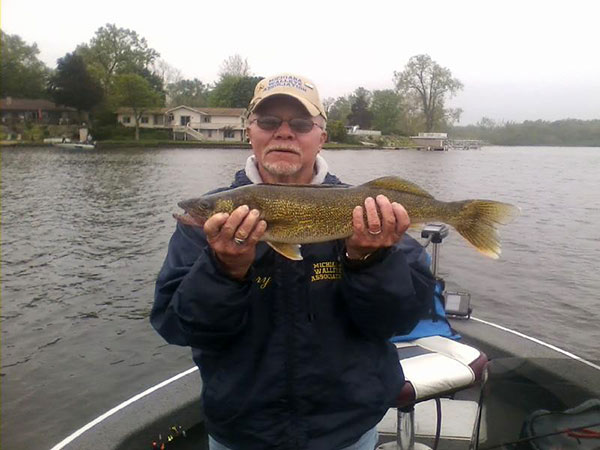By Louie Stout
 Barry Ukele with the Michiana Walleye Association shows off a nice walleye he caught from the St. Joe recently. The club helps the DNR stock walleyes in the river, and, according to recent surveys, last years young fish survived quite well.Theres good news for St. Joseph River walleye fishermen.
Barry Ukele with the Michiana Walleye Association shows off a nice walleye he caught from the St. Joe recently. The club helps the DNR stock walleyes in the river, and, according to recent surveys, last years young fish survived quite well.Theres good news for St. Joseph River walleye fishermen.
Fall surveys conducted by the Indiana DNR last month revealed better-than-average success of fish stocked by the DNR and the Michiana Walleye Association in 2011.
Biologist Neil Ledet spent October evenings cruising shallow river areas between Elkhart and Twin Branch dams with electro-shock equipment looking for one-year-old fish. The fish were temporarily stunned, captured, counted, measured and released.
We saw twice as many young fish as we normally do, said Ledet. We got about 25 fish per hour, whereas fall catch rates of 12 to 15 per hour with our gear are more typical.
Furthermore, Ledets research turned up quite a few mature fish, with most in the 16-18 inch range and one pushing 24 inches. The 13 inchers should reach legal size by late summer or fall of 2013.
The one year olds were running about 13 inches and were fat, with weights above normal for that age group, he added. The fish are doing quite well.
Why the exceptional survival of young fish?
Ledet admits that is the question that biologists struggle to answer.
Sometimes you hit it just right and other years you dont, he noted. But I will say that the larger fish were stocking seem to make a huge difference.
A few years ago, the DNR and MWA began acquiring river walleyes from a private Wisconsin hatchery that grows fish measuring 6 to 8 inches and stocking them in late fall. Prior to that, the DNR acquired fish from Michigan and stocked 2 inchers in higher numbers and earlier in the year.
Some of the fingerling stockings produced good results, but most didnt. The bigger walleyes stocked later in the year are producing far more promising results.
However, the bigger walleyes are difficult to raise because they require more time and space in the hatchery. Theyre pricey to buy from a private hatchery, but the return on investment appears worthwhile.
Indianas Fawn River Hatchery in Orland, Ind. has been experimenting with the late fall fish for stocking in some lakes. They produced about 13,000 two years ago, but the drought and heat limited last years production to only 5,500.
Unfortunately, thats not enough to satisfy northern Indiana needs so fish need to be purchased elsewhere.
On the bright side, Indiana has found success by stocking fewer fish, albeit bigger ones, in alternate years. The St. Joe wasnt stocked this year but will be stocked again next fall.
How many will get stocked in the river this year is contingent upon how much money the local walleye club can raise. For that reason, club members are appealing to the public for donations to support the project.
The DNR contributes to the cause with funds it receives from a partnership with I&M each year. For more information of how you can donate to the MWAs walleye stocking program, call Rick Nichols, 574-282-1916.